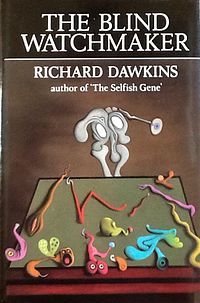Reception
Tim Radford, writing in The Guardian , noted that despite Dawkins's "combative secular humanism", he had written "a patient, often beautiful book... that begins in a generous mood and sustains its generosity to the end." 30 years on, people still read the book, Radford argues, because it is "one of the best books ever to address, patiently and persuasively, the question that has baffled bishops and disconcerted dissenters alike: how did nature achieve its astonishing complexity and variety?" [4]
Philosopher and historian of biology Michael T. Ghiselin, writing in The New York Times , comments that Dawkins "succeeds admirably in showing how natural selection allows biologists to dispense with such notions as purpose and design". He notes that analogies with computer programs have their limitations, but are still useful. Ghiselin observes that Dawkins is "not content with rebutting creationists" but goes on to press home his arguments against alternative theories to neo-Darwinism. He thinks the book fills the need to know more about evolution that creationists "would conceal from them." He concludes that "Readers who are not outraged will be delighted." [8]
Kenneth R. Miller writes that Dawkins "brilliantly explains how complex mechanisms and structures are put together by the process of evolution" adding "It is true that he makes certain theological points that I don’t agree with." [9]
Jerry Coyne also recommends the book: "I’ve always thought of Dawkins as an extremely smart child. He is not a child of course, he’s a really brilliant man. But he looks at things with the eyes of a child, in a way that I don’t think any scientist who wrote really well, including Stephen Jay Gould, ever could. He sees things with this fresh viewpoint that brings them alive." [10]
The American philosopher of religion Dallas Willard, reflecting on the book, denies the connection of evolution to the validity of arguments from design to God: whereas, he asserts, Dawkins seems to consider the arguments to rest entirely on that basis. Willard argues that Chapter 6, "Origins and Miracles", attempts the "hard task" of making not just a blind watchmaker but "a blind watchmaker watchmaker", which he comments would have made an "honest" title for the book. He notes that Dawkins demolishes several "weak" arguments, such as the argument from personal incredulity. He denies that Dawkins's computer "exercises" and arguments from gradual change show that complex forms of life could have evolved. Willard concludes by arguing that in writing this book, Dawkins is not functioning as a scientist "in the line of Darwin", but as "just a naturalist metaphysician". [11]
This page is based on this
Wikipedia article Text is available under the
CC BY-SA 4.0 license; additional terms may apply.
Images, videos and audio are available under their respective licenses.

